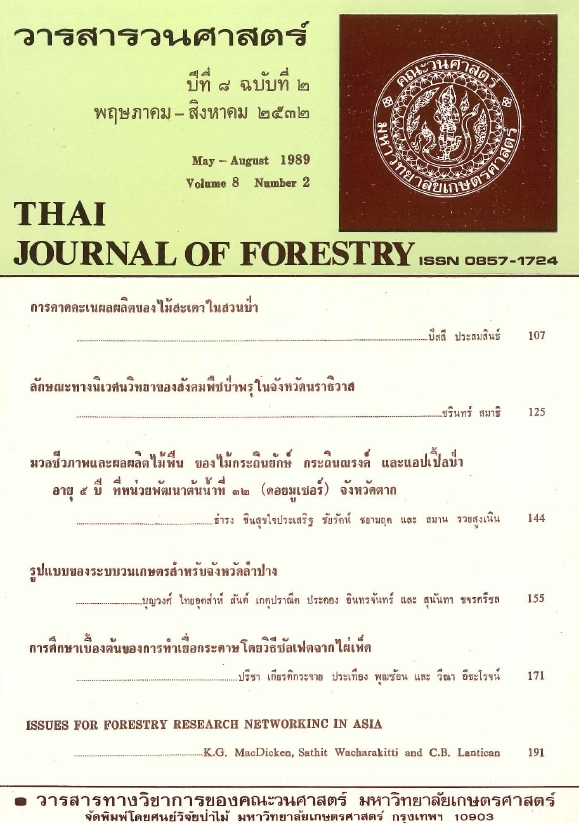รูปแบบของระบบวนเกษตรสำหรับจังหวัดลำปาง
Main Article Content
บทคัดย่อ
การศึกษารูปแบบของระบบวนเกษตรที่น่าจะเหมาะสมสำหรับจังหวัดลำปางครั้งนี้ได้กระทำโดยการตรวจเอกสารควบคู่กับการสำรวจภาคสนาม เพื่อให้ทราบถึงความต้องการเบื้องต้น สภาพความเป็นอยู่ ฐานะทางเศรษฐสังคมของราษฎร พืชพันธุ์ดั้งเดิมและพืชพันธุ์ที่ราษฎรคุ้นเคยกับวิธีการเพาะปลูก เก็บเกี่ยว และลักษณะดิน สภาพภูมิประเทศ ภูมิอากาศของจังหวัดลำปาง รูปแบบของระบบวนเกษตรที่เหมาะสมในที่นี้วัดจากข้อกำหนด ๔ ประการ คือรูปแบบนั้นต้องได้รับการยอมรับจากราษฎรในท้องถิ่น เป็นรูปแบบในระดับเพื่อยังชีพไม่ใช่ระดับเชิงพาณิชย์ พื้นที่เพาะปลูกต้องมีขนาดเล็ก และต้องถือว่าพืชกสิกรรมหรือพืชอาหารสัตว์เป็นพืชประธาน โดยมีพันธุ์ไม้ป่าหรือไม้ยืนต้นเป็นพืชแทรก จากข้อกำหนดดังกล่าวผนวกเข้ากับสภาสภาพแวดล้อมของจังหวัดลำปาง ทำให้สามารถแบ่งรูปแบบวนเกษตรออกได้ ๑๓ รูปแบบ โดยจำแนกตามระดับการยอมรับของราษฎรได้ ๓ กลุ่มคือกลุ่มที่ ๑ ราษฎรยอมรับได้ในระดับสูงมี ๔ รูปแบบ คือ การปลูกไม้ผลยืนต้นแทรกในนาข้าว การปลูกไม้ผลยืนต้นควบพืชไร่ การปลูกไม้ผลยืนต้นควบพืชอาหารสัตว์ และระบบวนเกษตรแบบผสมผสาน กลุ่มที่ ๒ ราษฎรยอมรับได้ในระดับปานกลางมี ๓ รูปแบบ คือ การปลูกไม้ไผ่ในนาข้าว การปลูกไม้ไผ่ควบพืชไร่ และการปลูกไม้ไผ่ควบพืชอาหารสัตว์ และกลุ่มที่ ๓ ราษฎรยอมรับได้ในระดับต่ำมี ๖ รูปแบบ คือ การปลูกไม้ยืนต้นขนาดใหญ่สำหรับแปรรูปหรือใช้สอยแทรกในนาข้าว การปลูกไม้สำหรับใช้ทำฟืนเผาถ่านแทรกในนาข้าว การปลูกไม้ยืนต้นขนาดใหญ่แทรกในแปลงพืชไร่ การปลูกไม้สำหรับใช้ทำฟืนเผาถ่านแทรกในแปลงพืชไร่ การปลูกไม้ยืนต้นขนาดใหญ่ควบพืชอาหารสัตว์ และการปลูกไม้สำหรับใช้ทำพื้นเผาถ่านควบพืชอาหารสัตว์
Downloads
Article Details

อนุญาตภายใต้เงื่อนไข Creative Commons Attribution-NonCommercial-NoDerivatives 4.0 International License.
ข้าพเจ้าและผู้เขียนร่วม (ถ้ามี) ขอรับรองว่า ต้นฉบับที่เสนอมานี้ยังไม่เคยได้รับการตีพิมพ์และไม่ได้อยู่ในระหว่างกระบวนการพิจารณาตีพิมพ์ลงในวารสารหรือสิ่งตีพิมพ์อื่นใด ข้าพเจ้าและผู้เขียนร่วม (ถ้ามี) ยอมรับหลักเกณฑ์และเงื่อนไขการพิจารณาต้นฉบับ ทั้งยินยอมให้กองบรรณาธิการมีสิทธิ์พิจารณาและตรวจแก้ต้นฉบับได้ตามที่เห็นสมควร พร้อมนี้ขอมอบลิขสิทธิ์ผลงานที่ได้รับการตีพิมพ์ให้แก่วารสารวนศาสตร์ คณะวนศาสตร์ มหาวิทยาลัยเกษตรศาสตร์ กรณีมีการฟ้องร้องเรื่องการละเมิดลิขสิทธิ์เกี่ยวกับภาพ กราฟ ข้อความส่วนใดส่วนหนึ่ง หรือ ข้อคิดเห็นที่ปรากฏในผลงาน ให้เป็นความรับผิดชอบของข้าพเจ้าและผู้เขียนร่วม (ถ้ามี) แต่เพียงฝ่ายเดียว และหากข้าพเจ้าและผู้เขียนร่วม (ถ้ามี) ประสงค์ถอนบทความในระหว่างกระบวนการพิจารณาของทางวารสาร ข้าพเจ้าและผู้เขียนร่วม (ถ้ามี) ยินดีรับผิดชอบค่าใช้จ่ายทั้งหมดที่เกิดขึ้นในกระบวนการพิจารณาบทความนั้น”


